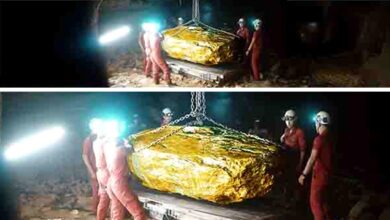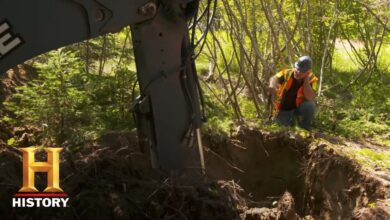The Curse of Oak Island: ANCIENT VIKING ARROWHEAD UNEARTHED (Season 12)
The Curse of Oak Island: ANCIENT VIKING ARROWHEAD UNEARTHED (Season 12)

…approximately 625 miles
to the northeast
in Newfoundland, Canada…
-MARTY: Hello!
-LORETTA: Hi.
-KEVIN: Hi there.
Welcome to L’Anse aux Meadows.
I’m Marty. I have brought
-the Oak Island contingent here.
-Oh, lovely.
NARRATOR:
…Marty Lagina
along with researchers
Doug Crowell
and Emiliano Sacchetti,
archaeologist Laird Niven
and archaeometallurgist
Emma Culligan
are meeting with Loretta Decker,
a manager for Parks Canada,
and archaeologist Kevin Smith
at the national historic site
known as L’Anse aux Meadows.
This is, as you know,
L’Anse aux Meadows
national historic site.
So L’Anse aux Meadows is
the very first evidence
of European presence
in North America.
The Norse here were
coming from Greenland
around the year 1000.
NARRATOR:
Encompassing
nearly 31 square miles,
L’Anse aux Meadows is currently
the only verified Viking
settlement in North America.
Since its discovery in 1960
by Norwegian explorer
and writer Helge Ingstad,
nearly 800 Viking
and Norse artifacts
have been discovered here
in addition to the remains
of eight buildings,
including a forge
for the purpose
of producing iron tools.
The reason
we came here is because
these two gentlemen went
on an expedition to Europe
and they sort of did a kind
of an east to west passage.
It led to Scandinavia
and they found evidence
that the Norse might have been
somehow involved on Oak Island.
We followed the trail
as far as Iceland.
So we thought
the logical place to pick it up
was here in Newfoundland.
Makes sense.
RICK:
How are you?
-(Emiliano laughs)
-Good to see you again.
NARRATOR:
In 2023,
Doug, Emiliano
and other members of the team
traveled to medieval sites
in Italy…
-ALEX: Oh. Look at these.
-PETER: Oh, wow.
NARRATOR:
…Denmark and Iceland…
Wow. Look at this.
NARRATOR:
…to investigate
an incredible theory:
That during
the early 13th century,
Norse descendants of the Vikings
helped members
of the Knights Templar
transport priceless
religious treasures
from Europe to Oak Island.
You see the Templar cross?
NARRATOR: Incredibly,
at numerous locations
where researchers believe
that both groups intermingled,
the team saw a number
of symbols and artifacts
that are identical to others
that have been discovered
over the past two centuries
on Oak Island.
Now, Marty and the team are
looking for more evidence
at L’Anse aux Meadows
that may also help connect
the descendants of Vikings
and the Knights Templar
to the Oak Island mystery.
LORETTA:
We know from evidence here
that this would be
like establishing
a base camp on the Moon.
This is essentially a base camp
for resource extraction.
They’re coming here
because there’s
resources in this region.
Not just
the L’Anse aux Meadows area
but this entire region.
Well, that sort of segues nicely
into why we’re here.
It’s not disputable
that the Vikings
-or the Norse were here.
-Mm.
What we’re trying to figure out
is where they might
-also have gone. (chuckles)
-(laughs)
-Right.
-Specifically, on Oak Island.
-LORETTA: Yes.
-You know,
I mean, did–
could they have visited?
Could they have been part
of what went on there?
They may not have been here
during the summers.
-This is the wintering camp.
-Mm-hmm.
This is probably where
everybody is
congregating to in the fall…
-Mm-hmm.
-…after they come back
from the expeditions,
which led them further south.
Okay. This is the only
proven site in North America.
Do you believe there are others?
The sagas talk
about another place called Hóp.
Hóp was the place where
they worked in the summer.
So yes, I do think
there was at least Hóp.
And that’s not been identified?
That’s not been
identified yet. No.
But it’s supposed to be
somewhere to the south of here.
So the other
interesting thing, though,
we know that they’re going
further south because we have
butternuts and a butternut burl
here in the collection.
They were found just nearby.
So in case you’re wondering,
butternuts have never
grown here.
Right.
Right.
What geographic area
are they known to have grown in?
The furthest north is
in that Nova Scotia,
New Brunswick region.
Never here.
That proves
they did go as far south
-as Nova Scotia, for certainty.
-Yeah. Yeah.
DOUG:
The butternut seed infers
that the Norse explored
much further south…
…because
that butternut seed only grows
between New Brunswick
and New England.
And that’s important to us,
because in order to obtain
that butternut,
they may have came
to Oak Island.
You said that Hóp was, um,
the summer camp…
-Yes. Yes.
-…mentioned in the sagas.
So, could Hóp be where
they found those butternuts?
-Or…
-Certainly.
-…could that be Nova Scotia?
-Certainly.
Certainly.
-That’s real interesting.
-LORETTA: Yeah.
MARTY:
That means they could have gone
as far south as Oak Island.
Yeah. Yeah.
DOUG:
Speaking of possible
connections between
the Viking descendants
and the Templars,
-we know the sagas even state
that the Norse visited Rome…
-Yeah.
-…to meet with
the Pope, right?
-Yeah.
The Templars
were a Catholic order,
and that put the Pope
in direct control of them.
-Yeah.
-KEVIN: Right.
I think all of those sagas,
they all–
when you see
when they’re written–
they all– especially
the ones dealing
with this area– they’re all
linked into the Church.
-They were claiming land
to the west.
-Yeah.
-Yeah.
-DOUG: On the island,
we’ve gotten some results
in the past that indicate
-European activity
in the 13th century.
-Yeah.
-Which is weird.
-Yeah. So, when you hear
those dates,
you automatically begin
to think the Norse.
-Yeah.
-NARRATOR: It is
well-documented,
This is all
incredibly interesting,
and we are very keen
to learn more.
So, what’s next?
LORETTA:
Well, come with me
and I’ll show you.
NARRATOR:
While Marty and the team
LORETTA:
Everybody, this is Ragnar.
continue searching for clues
at L’Anse aux Meadows…
-Good day.
-BOTH: Hello.
-Also, my real name
is Mark. Uh…
-(laughter)
NARRATOR:
…Marty Lagina
and other members of the team
continue their tour of
the historic Viking settlement
known as L’Anse aux Meadows.
I’ve been trained in
the Viking Age aspect
of blacksmithing,
and I’ve been working here
for 25, uh, seasons now, yeah.
To give you some insight
on why we’re here,
in our quest, you know,
down in Oak Island,
we are starting to suspect
that somehow, the Norse
may have had something to do
with what happened there.
DOUG: Last year,
we managed to reacquire
an artifact that was said
to have been found in a dig
in 1965,
and it’s this item here
that Laird has.
We showed that to an
archaeologist over in Denmark,
and she thought
it was very reminiscent
of the Viking time period.
DOUG:
Do you think
that weapon point could be
made using your authentic,
early techniques?
It’s possible.
I’ve made arrows, uh,
look like this.
Have you tested
anything with it? Or…
EMMA:
I’ve done XRF scans on it,
and it’s definitely not,
like, 1700s post.
So, the scans are ready.
NARRATOR:
In 2023,
Emma Culligan analyzed
the arrowhead
in the Oak Island lab
using an X-ray
fluorescence spectrometer,
a device that emits
nondestructive radiation
in order to identify
the elements
that make up
an object’s composition
and which can help to determine
their age and origin.
EMMA:
I think these levels
would indicate
like, pre, you know, 1600s.
DOUG:
It may be supportive
of these other dates
from our other findings
on the island
that we have
in a medieval context.
Yeah. Exactly.
MARTY:
He was pretty good?
The guy who made that?
Yeah, he was pretty good.
(laughter)
Yeah.
MARK: So, this stuff
on the rock here that you see,
I can pass it around to you.
All right, and you can spread
it around, spread it around.
There you go,
just pass it around.
-That’s bog ore. Okay?
-Yeah.
Generally, what bog ore is,
there’s two major components,
there’s ferrous oxide and sand.
Where you find this stuff
is actually in the bog.
So, it’s prevalent
in this kind of environment.
A little bit closer
to Nova Scotia,
Oak Island has a swamp, as well.
NARRATOR:
Bog ore is a naturally forming
iron deposit
typically found
in swamps or rivers,
and has been used across Europe
in order to forge
tools and weapons
dating as far back
as the fifth century BC.
It was also a material
commonly used by Vikings
and their descendants.
Is it possible
that the iron arrowhead
was also made with bog ore?
And if so, could it help prove
that the artifact
is of Scandinavian origin?
We have some bog iron
that’s taken from the region
that we can give you, Emma,
for testing.
Yeah, I’m really excited
to collect any kind of data
of bog iron and…
in the future, I could
compare Oak Island artifacts
to potential bog iron.
Oak Island has become so complex
in this time we’ve spent there,
and with so many
different possibilities,
that we’re just trying
to eliminate some.
Or gather some.
So, this is– this is excellent.
I’m pretty charged up.
I think Rick’s gonna be
very interested in the results
of our mission
to L’Anse aux Meadows.
The trip was
absolutely worth doing.
Mark, many thanks.
This has been very informative.
Really good stuff.
Loretta, Kevin,
thank you very much.
We’ve got a lot of data here.
We’re gonna get back
to the island and go through it.
-LORETTA: Thanks for coming.
-KEVIN: Absolutely.








